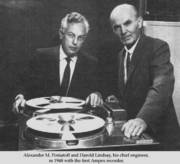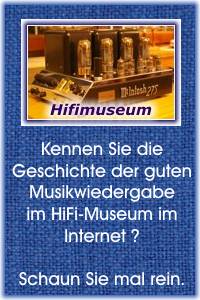April 1982 - Harold W. Lindsay (1909-1982) died by cancer
IN MEMORIAM - from Peter Hammar - Journal of AES Vol. 30, No. 9, 1982 Sept - (page 691).
.
The audio world lost a good friend on April 1st.
Harold W. Lindsay, the man who designed America's first professional audio recorder, the Ampex Model 200, lost a battle with cancer on that day, one month short of his 73rd birthday.
Es waren 4 Namen - die Geschichte geschrieben hatten
Four engineers in audio history have been crucial to the success of modern magnetic recording: the Danish electrician Valdemar Poulsen, inventor of the first wire recorder in 1898; Fritz Pfleumer, the German inventor who built the world's first working tape recorder (1928-30); John T. Mullin, the first American to build a prototype high-fidelity tape recorder from German Magnetophons (1946), and Harold W. Lindsay, who designed America's first commercially successful hifi tape recorder in 1947-48. - All four of these men are the unsung heroes, the Edisons, of our profession.
.
- Anmerkung : Das ist eine leider viel zu kurz gefasste typisch amerikanische Memoriam- "Story", die aus unserer Sicht zu vereinfacht darstellt, wer alles an den AEG Magnetophones mitgearbeitet hatte.
Die beiden Deutschen aus Berlin, die über die geniale Vormagnetisierung "gestolpert" waren, wären auf jeden Fall in diesem Context zu erwähnen - genauso wie die Konstruktion des Magnetkopfes von Eduard Schüller. Und auch die Präsentation des deutschen AEG K4 mit !! HF Vormagnetisierung. in Washington DC - bereits im November 1945 - wird völlig ignoriert. So zeichnet sich immer noch das Bild aus Ampex Marketing-Sicht ab und das ist definitv zu wenig.
.
This is Harold Lindsay's story.
Born in San Diego in 1909, Harold spent his formative years in Oakland, CA. A good electrical engineer implements his good ideas deliberately, to avoid electrocution, if nothing else. Imagine young Harold, age 6, budding engineer, carefully lowering a paper clip tied to a long string into a hot light bulb socket.
The small explosion that followed confirmed his ideas about electricity! The incident characterized Harold's approach to engineering: always willing to venture into the unknown, yet doing so with care and intelligence.
.
Der "Schwarze Freitag" unterbrach viele Lebensläufe
The Crash of 1929 interrupted Harold's education at the University of California at Berkeley. His first engineering job was at Shell Development Co. near Oakland, where he began to perfect the skills that he would later need to build the Ampex Model 200: drafting, industrial design, metallurgy (including hydrogen annealing), electronic design and measurement, machining and manufacturing, and quality control.
Early on, Harold also demonstrated the one quality that endeared him most to his fellow workers and his companies' customers: he deeply cared about other people, always thinking how his designs would give others the most benefit and the least trouble.
.
During World War II .......
During World War II, after moving from Shell to the Lawrence Laboratory in Berkeley, Harold designed a product he knew had to satisfy his "customers."
Allied airmen, badly wounded and unconscious in mid-flight at 20,000 feet during bombing runs over Germany, were routinely dropped by parachute to almost certain medical treatment as prisoners of war.
A last parachute drop into enemy hands was always safer than certain death on the long flight back to base in Britain. But the wounded airmen were freezing and suffocating with their parachutes opening at 20,000 feet.
At Lawrence, Harold designed one of the first barometrically-activated parachute releases ever made for mass production. A postwar review of carefully-kept German war records on downed Allied airmen showed that not one of the Lindsay-designed releases ever failed to open.
During the war, Harold continued his work at Lawrence on the Manhattan Project, designing control and measurement equipment used in atomic research.
.
In 1946 - a job at Litton Engineering and Dalmo
In 1946, Harold went to work as a design and test engineer at Litton Engineering, later joining Dalmo Victor in San Carlos, CA.
It was at Dalmo that he met Alexander M. Poniatoff, a founder of Ampex, a tiny motor subcontractor for Dalmo. It was Poniatoff who convinced Harold to join Ampex's search for a professional post-war product.
But it was Lindsay who convinced Poniatoff that a new German recording technology called "magnetic tape" could be made and sold in America. Jack Mullin's 1946 May 16 San Francisco demonstration of his German Magnetophon recorder was the catalyst for Harold.
.
Harold mochte schon immer gute Musik und guten Sound
Since his youth, Harold had been a lover of good music and good sound. Like Valdemar Poulsen, Fritz Pfleumer, and Jack Mullin, Harold was a dedicated audiophile, gradually turning his hobby into a profession.
From the 1930s, his close contacts with audio pioneers such as James B. Lansing kept Harold in touch with all the latest developments in high-fidelity sound reproduction.
Imagine the delight of summer picnickers at Tilden Park in the East Bay hills across from San Francisco, who, from 1940 to 1950, were treated to Sunday afternoon recorded "concerts in the park" through Rek-o-Kut turntables, Lansing Iconix loudspeakers and amplifiers of Harold's own design.
The image of those happy music lovers still brought Harold warm memories 30 years later.
.
Ab December 1946 bei AMPEX - als "two man team"
In December of 1946 Alex Poniatoff made Harold Lindsay project engineer and chief designer of the Ampex Model 200, as that first machine was called.
Myron Stolaroff, his associate on the project, completed the two-man team. Remember that the idea of tape replacing tried-and-true transcription disks in studios and radio stations was, to all but a few visionaries, a wild idea.
Sure, you could edit tape with a pair of scissors and make consistently high-quality, uninterrupted recordings for 20 minutes and longer, on a reusable product that was cheaper to use than blank recording disks.
But broadcast and studio executives and engineers are a cautious lot. Harold Lindsay knew that the first Ampex tape recorder had to be as "rugged and reliable" - probably his two favorite words - as the Scully or Westrex disk lathes (Platten-Schneidmaschinen für die 78er Schellack-Platten) then in use.
.
Es gab da auch den "BK-401 Soundmirror" von Brush ....
America's first tape recorders, the Brush BK-401 Soundmirror (der "Klangspiegel") and Richard Ranger's Rangertone were not good enough to convince audio engineers that tape was a professional recording medium.
Harold knew that the Model 200 would have to prove to broadcasters that tape was rugged and reliable enough for the daily pounding the machines would get.
.
- Anmerkung : Der Deutsche Ingenieur aus der AEG (Dr. ??) Samuel Beghun mußte 1936 "auf den letzten Drücker" aus Deutschland abhauen, weil er jüdische Wurzeln hatte und so kam er in USA bei der Firma "Brusch Development" - irgendwo in den Rocky Mountains in den Bergen - unter und durfte dort diese phänomenale deutsche Entwicklung des Magnetophones weiter verfolgen. Der Soundmirror ist daher sein Kind, aber noch mit Papierband - das Kunststoff-Band von der BASF kannte er vermutlich noch nicht oder nicht mehr. Das Papierband war aber nicht reißfest genug und somit war es ungeeignet. Das Gerät wurde ein Flop.
.
The recorder had to be more than good.
And it was. - The way wasn't always easy. Reportedly, not a few times Harold had to convince the cost-conscious Alex Poniatoff to use better motors, better brakes, better metal - everything to make the machine meet the recordists' high expectations of a professional machine. Harold succeeded. The Model 200A made tape recording a commercial reality in the U.S.
Although the Ampex Model 200A sold for more than a year's salary in 1948 - $4.000 - American broadcasters in 1948 accepted tape as their new medium, quite literally overnight.
The initial skepticism about tape at ABC's New York headquarters (despite Bing Crosby's success the same year with Jack Mullin's two Magnetophons) quickly vanished with the success of the Model 200.
.
Die ersten AMPEX 200 standen bei ABC - 2,618 Stunden
Frank Marx, ABC's engineering chief, wrote in 1948 that after 22 weeks of constant use for daylight savings delayed-broadcasts and for the Crosby and other shows, the network had lost only 3 minutes out of 2,618 hours of on-air recording!
.
Es gab nur 112 Exemplare des AMPEX 200A Recorders
The Ampex Museum of Magnetic Recording's collection includes a Model 200, serial number 66 (only 112 were made) donated by Craig Curtis of NBC Burbank's recording department that was on-line there for 31 years.
With no major repairs or modifications, this machine still can record some fine-sounding tapes! In fact, tapes carefully mastered in 1948 on the Ampex Model 200 meet most of today's criteria for "professional-quality high-fidelity" audio reproduction.
.
1948-49 wurde das Lindsay Team grösser
Joined at Ampex in 1948-49 by other talented engineers such as Walt Selsted and Frank Lennert, Harold Lindsay went on to help design the standard of all U.S. professional audio recorders, the Ampex Model 300.
The same dedication to quality and reliability, his never-ending concern for the people who would use the machines, carried through to the Model 300 and subsequent Ampex audio, data, and video recorders.
If Alex Poniatoff had wanted to name the one engineer most responsible for Ampex's success over the last 35 years, he would have had to choose that talented man who cared for people above all else. We shall all miss Harold Lindsay.
Audio Eng. Soc, Vol. 30, No- 9, 1982 September
.
Bild :
Harold Lindsay, chief designer of the Ampex Model 200, does final checkout on one of the first 200s in early 1948.
.


